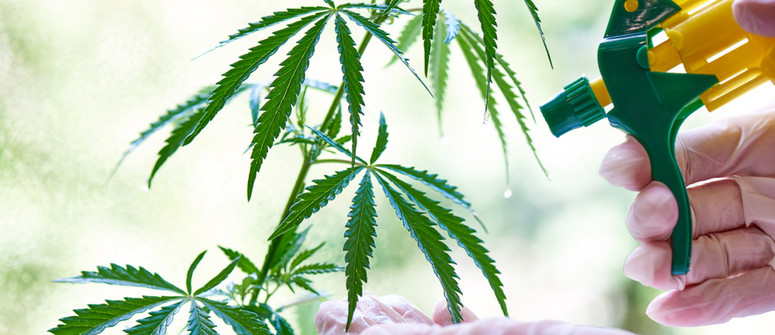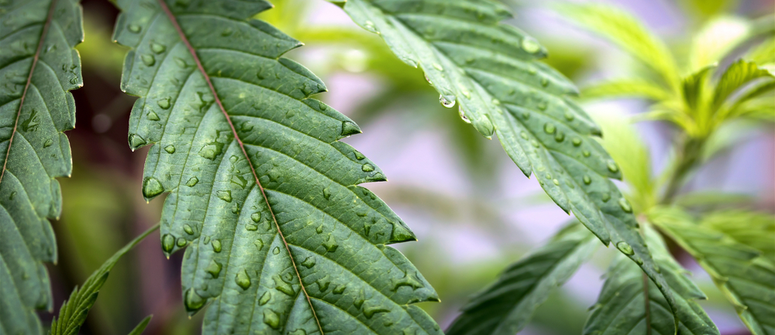How and why to foliar feed cannabis plants

Most cannabis growers feed their plants through the roots, but is this the only method available? Absolutely not. Foliar feeding, aka feeding via the leaves, is a very efficient way of supplying nutrients. Continue reading to find out how and when to use this method in your cannabis grow!
Contents:
Feeding cannabis plants can feel like a chore sometimes. Reading labels, measuring different types of fertilisers, switching your nutrients from vegetative to flowering… And what about overfeeding, underfeeding, and nutrient lockout? But what if we told you that the use of foliar sprays could make your feeding schedule much easier? Before we go into details, we want to highlight that foliar feeding is not a substitute for normal feeding. Traditional feeding happens through the roots.
But first, what is foliar feeding?
What Is Foliar Feeding?
Foliar feeding, as the name suggests, is the process of feeding (supplying nutrition) through the leaves of a plant. But how is this even possible? To understand this, we must first dive into a little bit of biology.
Plants undergo a marvellous process called photosynthesis. This is basically the way plants process and transform the nutrients in their feed. Although nutrients are in the growing medium (soil, coco, hydro), the actual transformation happens in the leaves. Here, the stomata—the pores in the epidermis of the leaves—open and close to allow gases to pass through. The plants use carbon dioxide and water, together with light, to synthesise nutrients. The byproduct of this conversion is oxygen.
You can think of stomata like pores in human skin. They expel water through a process called “stomata transpiration”, in much the same way that our skin transpires water. But they can also absorb it. Foliar feeding uses this mechanism to deliver nutrients to the stomata via a mist of water.
This method is also said to be 3–5 times more effective than traditional “root” feeding. But how does this benefit your cannabis plants?
Foliar Feeding for Weed
There are several reasons you should try and integrate feeding through the leaves of your cannabis plants. There are also cases where foliar feeding isn’t the best option, and should be avoided.
Benefits of Foliar Spraying Cannabis
• Very effective (in some cases, the nutritional uptake reaches 95%)
• Great way to remedy nutrient deficiencies
• Perfect for dealing with pests, parasites, or fungi
• No buildup of nutrients in the soil, which could cause nutrient lockout
• Iron accessibility for the plant (this is otherwise unavailable in soil/soilless media)
• Clones can benefit a lot from foliar feeding
Drawbacks of Foliar Spraying Cannabis
• Spraying liquids on leaves can cause solar burns due to the “magnifying lens” effect
• Undiluted solutions can lead to chemical burns and ruin foliage
• If foliar feeding is applied during the flowering stage, the nutrients can contaminate the buds
• Since foliar sprays are water-based, they can encourage the development of mould

When To Start and Stop Foliar Spraying Cannabis
It’s important to follow specific rules to ensure you get the most out of foliar feeding or foliar spraying to combat pests, fungi, etc. You should not add any stress or strain to your cannabis plants.
Foliar Spray During the Vegetative Phase Only
We advise foliar spraying your plants with a diluted nutrient solution during the vegetative phase. This is when your plants are getting bigger and taller with each passing day. Foliar feeding is very efficient with clones. Cuttings are quite vulnerable at the beginning, and need all of their energy to develop a strong root system. It’s difficult to feed plants via the roots when they don’t have roots yet. This is when foliar application becomes vital.
We also suggest ceasing foliar feeding within the first week of flowering. As soon as buds start to develop, you shouldn’t risk spraying anything near them, or you could contaminate them.
Rise and Shine: Foliar Spray in the "Morning"
There are also some guidelines regarding the best time of day to foliar feed. The stomata are open early in the morning, when the first light hits your plant. The same thing happens indoors, although your plants’ “early morning” might not coincide with yours. Whatever setting you are using, we advise foliar spraying your cannabis plants early in the morning or when your lights come on.
Remember the stomata transpiration we referred to earlier? When it’s hot, around midday, the stomata close to preserve moisture and water. It would be counterproductive to spray your leaves when the stomata are closed, as this will prevent any absorption.
Foliar spraying when the light is bright and direct will also cause solar burn. This is due to the lens effect. Droplets of water on your leaves act as a magnifying glass, thus making the light much more powerful. It’s easy to burn your foliage if you foliar spray during the hottest hours of the day, whether you are feeding them, fighting an infestation, or simply watering them.
How To Foliar Feed Cannabis
Step 1: Gather your nutrients of choice. Liquid nutrients, especially those designed for hydroponics, will work better in terms of infusion. If you don't have liquid nutrients, normal soil nutrients will work too. There are infinite ways to make a foliar spray, with different active compounds (neem oil, compost tea, seaweed, calcium, iron, etc.). All of them have different ratios of water and nutrients. We suggest using a growth booster for vegetation, with added micronutrients if you're not using your spray to treat a specific deficiency or pest.
Step 2: Add about 50% of the recommended dose to a spray bottle, and top up with fresh water.
Step 3: Wait until early in the morning to foliar feed your plants if you are outside, or when you first switch your lights on indoors.
Step 4: Spray your plants’ leaves and stems (the stomata can be found here too) profusely. Don't forget the underside of your foliage!
Step 5: If you are unsure about the strength of your nutrient solution, spray a few leaves first and see how they react to foliar feeding. If they curl up or show discolouration, further dilute the solution to another 50% (i.e. 25% of the original strength).
Foliar Feeding and Hydroponics
So, we explained foliar feeding and how it can be beneficial for your plants—but what about hydroponics? Foliar feeding is basically water and nutrients mixed together and administered to your plant. That sounds a lot like hydroponics, right?
If this is the first time you’ve heard this term, hydroponics is the technique of growing plants in a soilless medium. This could be just water, or, for added support, coco coir, rockwool, clay pebbles, perlite—the list goes on. The nutrients are then added to the water and absorbed via the roots just like traditional growing operations in soil.
That said, foliar feeding can still be used in hydroponics. Soilless media are more susceptible to pH fluctuation, and cannabis plants are quite picky when it comes to pH. In hydro, the ideal pH range is 5.5–6.1, and 5.8 is considered perfect. Within this range, plants absorb nutrients more efficiently.
pH tends to fluctuate, especially in a hydroponic system. It’s a lot easier to develop deficiencies if your growing medium is out of range. Foliar sprays can really help you. While you flush your plants and try to overcome the nutrient lockout, you can still supply the correct nutrients via the leaves. The same goes for a specific deficiency, or if you are trying to eradicate pests.
Is Foliar Feeding Cannabis Effective?
Overall, foliar feeding is an extremely effective way to supply nutrients to your cannabis plants. Compared to traditional “root” feeding, the foliar method is 3–5 times more effective in delivering macro and micronutrients to the plant. Some cases have found the uptake to be as much as 95%!
We also want to remind you that foliar feeding is not a substitute for normal feeding, and your root system needs all the help it can get to grow strong and thrive. A strong root system equals a strong plant.
Foliar spraying is an aid you can use in moments of need. If you are dealing with deficiencies, nutrient lockout, or pests/diseases, this highly effective method will get your plants back on track. Remember to dilute your solution and observe your plants’ response!




